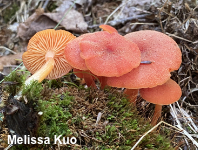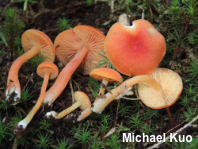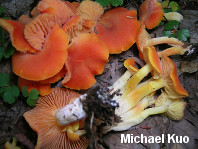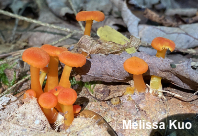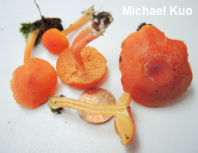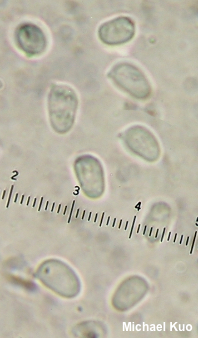| Major Groups > Gilled Mushrooms > Pale-Spored > Waxy Caps > Hygrocybe squamulosa |

|
Hygrocybe squamulosa [ Basidiomycota > Agaricales > Hygrocybaceae > Hygrocybe . . . ] by Michael Kuo As species of Hygrocybe go, Hygrocybe squamulosa is pretty robust, with a cap that regularly gets 6 cm wide. Otherwise, it looks a lot like any number of red and orange waxy caps, unless you're willing to spend some quality time getting into the fine points of waxy cap identification: Hygrocybe squamulosa has a dry cap and a dry stem, gills that are broadly attached to the stem but do not run down it, and a finely scaly cap surface. Similar waxy caps include Hygrocybe miniata, which is smaller, and Hygrocybe cantharellus, which is smaller and features gills that run down the stem. Description: Ecology: Precise ecological role uncertain (see Lodge and collaborators, 2013); appearing in woods under hardwoods or conifers, often in the vicinity of, or fruiting from, well-rotted, moss-covered stumps; growing gregariously or in loose troops; summer and fall; originally described from New Jersey; distributed in North America from roughly the Great Lakes to the east and north. The illustrated and described collections are from Michigan. Cap: 25–65 mm across; convex, becoming broadly convex, nearly flat, or shallowly depressed; dry or slightly tacky; innately, finely fibrillose at first, becoming minutely scaly; reddish orange to orange when young and fresh, fading to pale orange. Gills: Broadly attached to the stem; distant or nearly so; thick; pale yellow at first, becoming orange; short-gills frequent. Stem: 30–60 mm long; 4–10 mm thick; equal; dry; bald; pale orange to yellow, with a white base. Flesh: Yellowish. Odor and Taste: Not distinctive. Chemical Reactions: KOH negative on cap surface. Spore Print: White. Microscopic Features: Spores 5–8 x 3–4.5 µm; smooth; ellipsoid or slightly oblong, but only occasionally constricted; hyaline in KOH; inamyloid. Basidia 35–45 x 5–6 µm; 4-sterigmate. True hymenial cystidia absent, but filamentous pseudocystidia sometimes present on lamellar edge. Lamellar trama parallel. Pileipellis a collapsing trichoderm of hyaline, clamped elements 5–12.5 µm wide; terminal elements cylindric, with clavate, irregular, or subacute apices. REFERENCES: (Ellis & Everhart, 1894) Arnolds, 1995. (Saccardo, 1895; Hesler and Smith, 1963; Phillips, 1991/2005; Arnolds, 1995; McNeil, 2006; Bessette et al., 2012; Lodge et al., 2013.) Herb. Kuo 09120506, 08112010. This website contains no information about the edibility or toxicity of mushrooms. |
© MushroomExpert.Com |
|
Cite this page as: Kuo, M. (2021, April). Hygrocybe squamulosa. Retrieved from the MushroomExpert.Com Web site: http://www.mushroomexpert.com/hygrocybe_squamulosa.html |
